November 22, 2016
Approach to the meaning of the Pórtico de la Gloria and the figure of Master Mateo
Juan Ramón Corpas Mauleón
Physician and writer
During the Age of average, Compostela became the main focus of pilgrimages in the West. This is because it possesses an extraordinary asset: it contains the tomb of one of the twelve, and not just any one. It holds the precious relic of the apostle St. James the Greater, the "friend of the Lord". To contain it, from the 9th century onwards, successive basilicas Structures were built, until the cathedral that we can still contemplate today was built.
The present cathedral building was erected between the eleventh and thirteenth centuries. With two distinct construction phases: The first began in 1075, according to the Liber Sancti Jacobi; the last stone was laid in 1122 and consecrated in 1128. The second and final phase began in 1168, when the chapter commissioned Master Mateo to enclose the foot of the temple. And the cathedral was finally consecrated in April 1211, on Thursday morning of the second week of Easter, by Archbishop Pedro Muñiz, in the presence of King Alfonso XI of León and his son.
Master Mateo is considered the author of the west door, one of the four that give access to the basilica and the one that has most faithfully preserved its initial format: the Portico of Glory. An extraordinary ensemble that amazes his contemporaries and continues to impress the visitor today. And that composes a sacred space that envelops us. A large narthex housed between the two towers of the facade, which puts before our eyes a complete apocalyptic vision.
The duration of this work is well placed in time: it did not begin before 1168, date of the privilege of Fernando II of León, in which Mateo was entrusted with the work of the temple, and it was completed in April 1188, as can be seen on the lintel of the Portico, sample . Twenty years later.
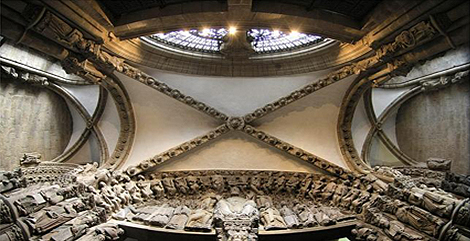
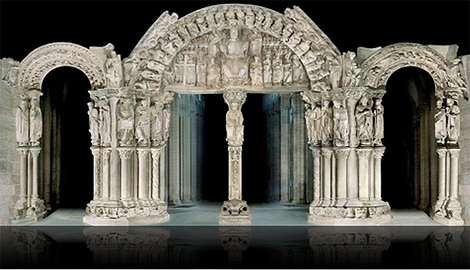
We are welcomed at entrance by the Apostle James enthroned in the mullion, on a marble shaft with the Tree of Jesse, the human genealogy of Christ, which is completed with the divine genealogy, sculpted as the Trinity-Throne of Grace, in the capital. On and around it, the whole portico keeps an unusual perfection and symmetry. In the first body of columns are represented prophets and apostles: Moses, Isaiah, Daniel and Jeremiah, confronted with Peter, Paul, James Zebedee and John. The central tympanum is presided over by an impressive seated Christ who sample his wounds, flanked by the evangelists. The apocalyptic vision continues with angels carrying the Arma Christi, with veiled hands on instrument bearers that have been on contact with the body of Christ. And around the arch, sit the twenty-four elders with the instruments that are to initiate the music in honor of the Lamb. Instruments represented with such astonishing and detailed precision that they constitute the most valuable testimony of medieval organology.
And in the archivolts of the side doors are presented the Anastasis and the Last Judgment, with the blessed as children lovingly accompanied by angels who, at times, become curious and frightened to watch the punishments that the demons inflict on the reprobate. In front of the tympanum, angels and seraphim, together with the images of the statues columns and the trumpeter angels in the corners complete the apocalyptic atmosphere.
In 1519 the chapter decided to close the cathedral at night, altering the exterior view of the portico. And in 1738 the medieval facade was demolished and replaced by the Obradoiro. With this, the old façade disappears, which we can virtually reconstruct almost in its entirety thanks to the 1657 drawing by Canon Vega y Vedugo and the recovered pieces, some of which are difficult to contemplate, on display at the Prado Museum until March 2017, along with a column statue, happy finding appeared in the recent restoration works.
The Portico is an astonishing work of synthesis that combines the technical, artistic, theological, liturgical, musical and symbolic knowledge of the time with the apocalyptic breath. And it creates an atmosphere endowed with a harmony and beauty whose spatial and plastic sophistication will not be equaled until the Italian Renaissance.
The director of this masterpiece, which inaugurates naturalism in Spanish art and creates a new way of conceiving art in which he introduces for the first time explicitly the formula of dialogue, is none other than the so often "mysterious" Maestro Mateo.
Not so mysterious. Less so, if compared to the cathedral builders of his time. There have been various conjectures about his origin, although today scholars assume his origin in León, something that agrees with the tradition that makes him the son of Pedro Deustamben, the Pedro Peregrino del Codex, an outstanding builder on the Camino, whose remains rest in the basilica of San Isidoro de León, whose reform and completion he was responsible for manager.
As for his life trajectory - if we accept the document that accredits him as director of the work of refurbishment of the Roman bridge(pons caesaris) of Puentecesures "on October 21, 1161, the master Mateo built the bridge of Cesures" - it would extend between the proximity of 1140 and the year 1217, a long and productive existence, the eighth centenary of whose end we will commemorate in 2017 with the opening to the public of its restored portico.
Along with a possible geographical and family origin and a plausible chronology, there are two indisputable documents: the aforementioned privilege of King Ferdinand II, and the epigraph on the lintel of the portico: "In the year of the Incarnation of the Lord, 1188, the day of the Kalends of April, the lintels of the main portico of the church of the Blessed James were placed by Master Mateo, who directed this portal from the foundations". registration This is a gesture of arrogance when he presents himself as the exclusive architect of the work and omits quotation of the bishops, the chapter and even the king, a detail that supports the legend that attributes to him the sin of arrogance.

In the year of the Incarnation of the Lord, 1188, MCCXXVI, on the 1st of April, the lintels of the main portico of the church of the
the lintels of the main portico of the church of Blessed Santiago were set by the master Mateo, who directed the work from the foundations,
by Master Mateo, who directed the work from the foundations.
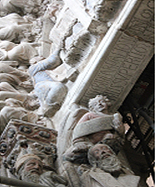
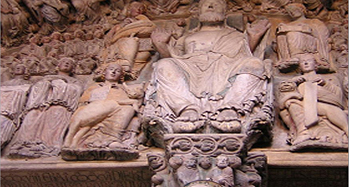
Although, in the completion of his work, he was represented on his knees, according to the story, in a gesture of repentance or humility, at the foot of the central pillar of his work and with his back to it. The popular Santo dos Croques.
From his training, the experts point out that it was made in the circle of Compostela, enriched with the influence of the Burgundian and, in all probability, of the Parisian, since Gelmirez sent his most gifted young masters and apprentices to France, to Paris.
But Mateo is not only the gifted sculptor that he has traditionally been considered. Today there is a general consensus that his role is that of a great director of works that for more than forty years (1168- 1211) carried out the remodeling and completion of the western body of the cathedral: crypt, the last sections of the nave and the western section, towers, vaulted portal with an opening to the exterior, tribune...The building was also completely refurbished in order to renovate, monumentalize and unify its exterior appearance, redoing the old architecture to adapt it to the new times - doorways, openings, lighting - and interior, with the creation of an extraordinary stone choir in the heart of the cathedral and the placement of the statue of St. James the Greater enthroned behind the main altar, a statue that repeats the model of the seated St. James of the mullioned window.
We know something, then, about our master. In addition, we can deduce from the documentation some of the urban properties he owned in the city ("Das casas que foron de mestre Matheu"), and almost certainly the location of the house where he lived, in front of the northern door of the basilica. Also, that he was a layman and had a family, at least one son: the teacher Pedro Mateo.
This is no small feat in the silent world of medieval builders.
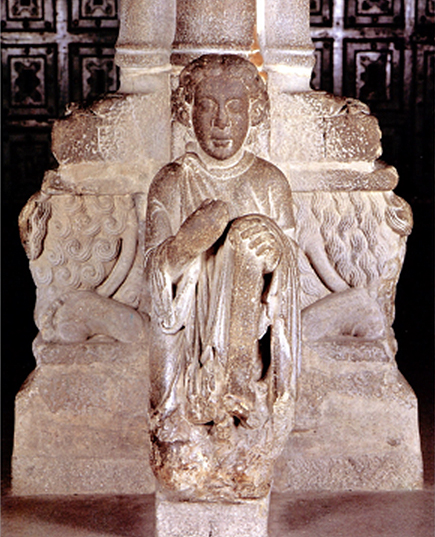
But we have above all its bequest and its artistic report . His monumental work, his cathedral, his Portico. The work to which he dedicated a lifetime, and which today, more than two hundred years later, continues to flood our hearts with joy and wonder.
